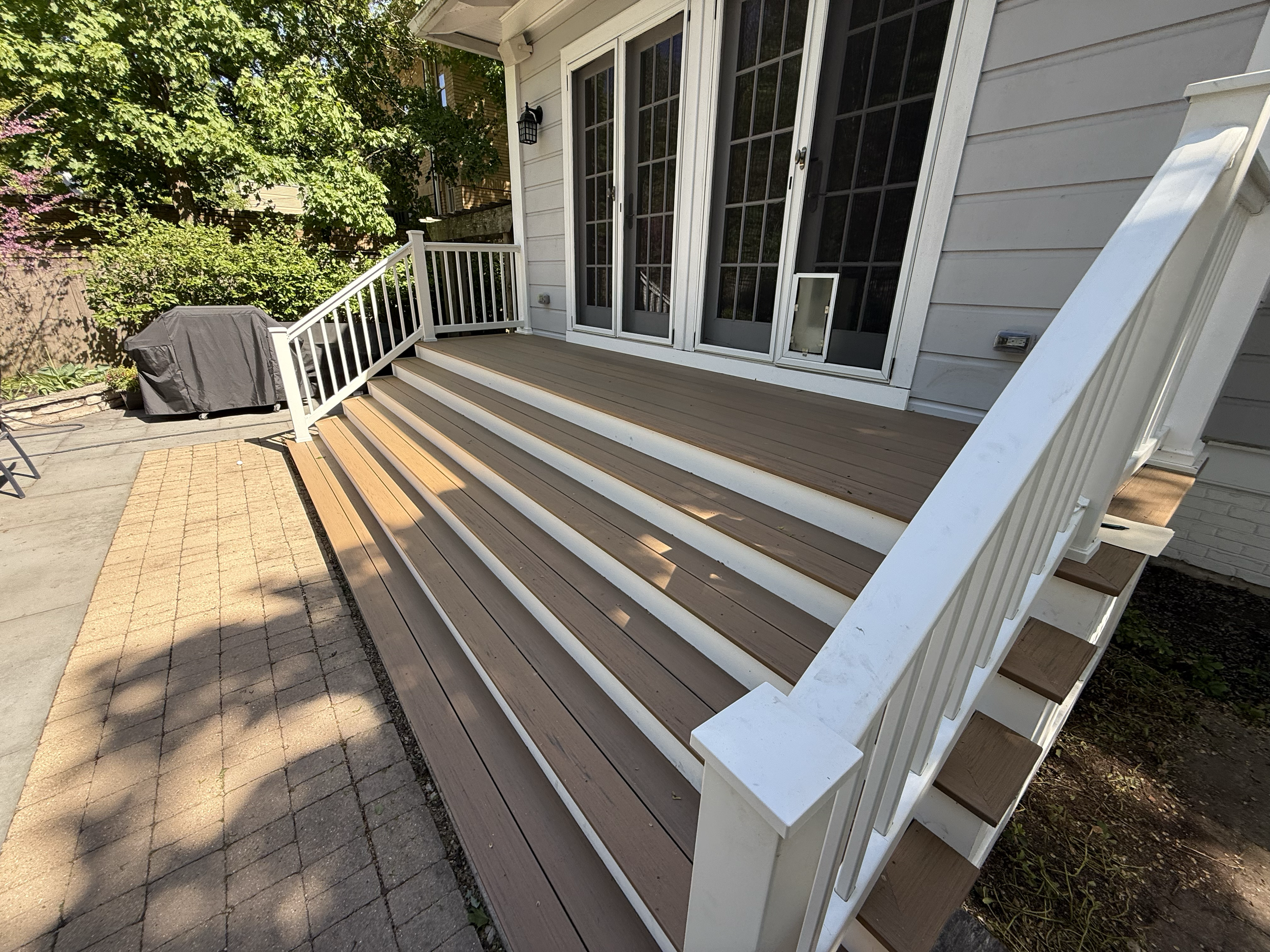Deck vs. Patio in the Midwest: What’s Best for Your Chicagoland Backyard?
North Shore Composite Deck Builder
In the Chicago area and North Shore suburbs, adding an outdoor living space is a smart investment — but deciding between a deck or patio isn’t one-size-fits-all. Your yard conditions, home elevation, and local climate will all shape the best solution.
Illinois brings extreme weather: snow, rain, humidity, and shifting soil. That means your outdoor structure needs to be both beautiful and built to last. In this guide, we’ll break down which is better — a composite deck or a stone or paver patio — based on what actually holds up in Chicagoland.
Deck or Patio? Quick Answers Based on Your Yard
Build a composite deck if your yard has uneven terrain, soft soil, or drainage issues — or if you want an elevated layout like a walkout.
Build a patio if you have a flat, dry, well-drained yard and want a seamless connection to your backyard or garden.
Evanston Trex Deck Installation
Climate Impact: Why Midwest Weather Matters
Illinois winters bring more than just snow — they cause dramatic freeze-thaw cycles. In areas like Lake Forest, Northbrook, and Wilmette, saturated soil freezes and expands, then thaws repeatedly. This movement can crack and shift hardscapes.
Decks, on the other hand, are anchored using deep footings below the frost line, which avoids surface-level soil movement altogether. The raised design allows water to drain naturally, keeping the frame dry and stable all year long.
NOAA’s Climate Data shows increased precipitation and variable freeze patterns in the Midwest — a key reason why above-ground structures perform better long-term.
Meanwhile, patios must be perfectly graded and built with a compacted sub-base. Without it, water can collect, freeze, and damage the surface over time.
Rain, Drainage & Heat: Functional Differences
Decks offer natural water drainage between boards — especially when built with composite materials like Trex or TimberTech. Patios require precise grading and permeable joints to avoid puddling.
In the summer, stone and concrete patios can retain heat. Some modern composite decking boards are engineered to reflect heat and remain cooler underfoot, making decks more comfortable to use during hot Chicagoland summers.
🔗 Learn more about composite technology from Trex’s engineering page.
Which Works Best for Your Yard Type?
🏞 Sloped or Soft Yards: Choose a Deck
In towns like Glencoe or Highland Park, yards often slope or have heavy clay soil. Decks are perfect in these cases because they can be installed without major excavation and easily adjust to grade changes.
🌿 Flat, Dry Yards: Patios Fit Well
If your lot is level and drains well — like many homes in Deerfield or Northfield — a paver or stone patio can provide a sleek, natural transition between indoor and outdoor spaces.
Design Possibilities & Features
A composite deck is great if you want:
Multi-level or wraparound design
Built-in lighting or railings
Under-deck storage or a walkout design
A patio may be best if you want:
An outdoor kitchen or built-in fire pit
Stone seating walls or planters
A ground-level space that integrates with landscaping
What Adds More Home Value in the Chicago Suburbs?
In upscale neighborhoods like Winnetka, Lake Bluff, and Evanston, homeowners often expect outdoor living upgrades.
Composite decks stand out for their year-round usability and minimal upkeep.
Stone patios, especially with features like fire pits or outdoor kitchens, can elevate a luxury backyard layout.
According to the 2024 Remodeling Impact Report by NAR, deck additions recoup up to 89% of their value at resale in the Midwest.
Go with a deck if you want something durable, flexible in layout, and better suited for yards with grade changes or water issues.
Choose a patio if you want something that blends seamlessly with your landscaping and works well with a flat yard.
How Installation Differs: Decks vs. Patios in Chicagoland
If you're planning an outdoor renovation in the North Shore or Greater Chicago area, it's important to understand what each build entails.
Deck installation typically begins with structural footings, framing, and code-compliant inspections — especially if you're building a second-story or walkout design. From there, composite decking boards, railings, and lighting are added. Most deck builds in neighborhoods like Evanston or Winnetka take about 1–2 weeks depending on complexity.
For a paver or stone patio, site excavation and grading come first. Then comes the sub-base compaction, edge restraints, and laying of each paver or stone. Finally, polymeric sand is swept into the joints to prevent weeds and shifting.
Want to see how we build step-by-step? Visit our patio installation page for Winnetka or browse our deck builder services in Evanston for full process details.
💬 Need Local Advice?
At Diamond Decking, we design and install composite decks and patios across the North Shore, Chicago, and suburbs like Glenview, Wilmette, Lake Forest, and Long Grove.
✅ Visit our composite decking page
✅ Explore our Lake Forest patio installation services
✅ Check out our Wilmette deck builder page
✅ Or get a free quote for your yard today


